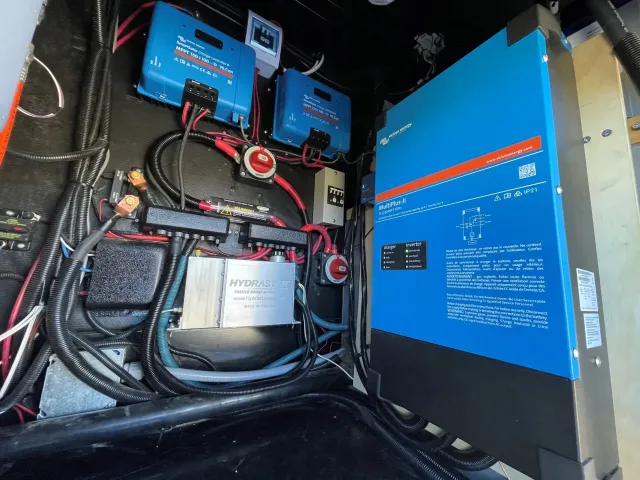The Ultimate Guide to Charging Deep Cycle Batteries
Understanding the nuances of deep-cycle battery charging is crucial for ensuring longevity and optimal performance. Whether you’re using these batteries for solar power storage, in boats, or for RVs, knowing how to charge them properly is essential. Deep-cycle batteries are designed to provide continuous power output over a prolonged period, but if they are not charged correctly, their lifespan and efficiency can decline over time.
What Are Deep Cycle Batteries?

Deep-cycle batteries are a specialised type of battery used for continuous, long-duration power delivery. Unlike standard starting batteries, which provide a high burst of energy to start an engine and then recharge quickly, deep-cycle batteries are designed to discharge energy slowly over an extended period. They are ideal for applications where power is needed consistently, such as off-grid solar systems, boats, and motorhomes, powering everything from water pumps and lights to communication equipment and recreational devices.
The construction of deep-cycle batteries differs significantly from that of standard starting batteries. They feature thicker plates and a more robust internal structure, allowing them to withstand repeated deep discharges without significant degradation. This design enables them to provide a steady amount of energy over time, though it does make them heavier and, in some cases, more expensive.
A key aspect of using these batteries effectively is understanding how their discharge and charge cycles work. When a deep-cycle battery discharges, it releases stored energy at a steady rate. However, if it is not recharged correctly, its internal chemical reactions become unbalanced, reducing capacity and causing long-term damage. Maintaining the right charging regime with a quality deep cycle batteries charger is crucial to keeping the battery stable and efficient.
How to Charge Your Battery Properly
Properly charged deep-cycle batteries will add to their longevity and optimal use. The optimum method is to be aware that deep-cycle batteries require a slower, more regulated charge than run-of-the-mill car batteries. A multi-stage charging system is usually recommended, with the bulk stage consisting of a quick charge to take the battery up to about 80 percent capacity. This is followed by an absorption phase, where the charge is decreased progressively as the battery is at maximum capacity. Finally, a float charge is supplied to keep the battery full but not charged in excess.
The best practice when charging deep-cycle batteries is to use a charger that has been specifically engineered for deep-cycle batteries. These chargers usually have modes that automatically switch between charging stages, so that the battery is not exposed to high voltage for a long time. Monitoring the battery voltage during charging is also important; overcharging can lead to overheating and water loss while undercharging can lead to sulphation, where lead sulphate crystals form on the battery plates and reduce their capacity.
Temperature is another key consideration when it comes to charging. A deep-cycle battery tends to have a specific range within which it’s meant to function, and deviating from it can affect how well the battery performs. Charging a battery, say, under very low temperatures might not work as effectively, while in excessively high temperatures it can cause accelerated chemical reactions leading to harm. Using a temperature-compensated charger will help to regulate the charging voltage to the battery’s operating conditions, delivering a safe and efficient charge every time.
How to Choose the Right Charger
When selecting a charger for your deep cycle battery, it is essential to choose one that can accommodate the unique properties of the battery. Opt for chargers that have multi-stage charging procedures, as these are responsible for keeping the battery healthy in the long run.
The deep cycle batteries charger should be able to automatically adjust its output to match the battery’s requirements during the bulk, absorption, and float phases. Compatibility with your battery’s voltage and capacity is also essential, so be sure to check the specifications carefully. Additionally, features such as temperature compensation and built-in safety mechanisms can help protect both the battery and the charger from potential damage.
Risk of Improper Charging
The risks of inadequate charging of deep-cycle batteries cannot be overemphasized. An overcharged battery not only gets heated, but it may end up with the internal components being damaged irreparably, and in extreme cases, losing electrolyte that reduces the capacity of the battery significantly.
Undercharging, however, results in sulphation – a process by which lead sulphate crystals are deposited on the plates of the battery, blocking its ability to hold a full charge. Both conditions ultimately shorten the life of the battery, resulting in increased replacement costs and downtime. Apart from this, the use of an incompatibility charger that doesn’t follow the multi-stage charging mechanism can result in unbalanced charging of battery cells, taking away further from efficiency and performance.
Deep cycle batteries are a key component in many applications, from renewable energy systems to marine and RV uses, and charging them correctly is the secret to optimal performance and life. Knowing how to charge them, choosing an appropriate charger, and knowing the risks of improper charging are all key steps in maintaining these high-performance energy storage devices at their best.